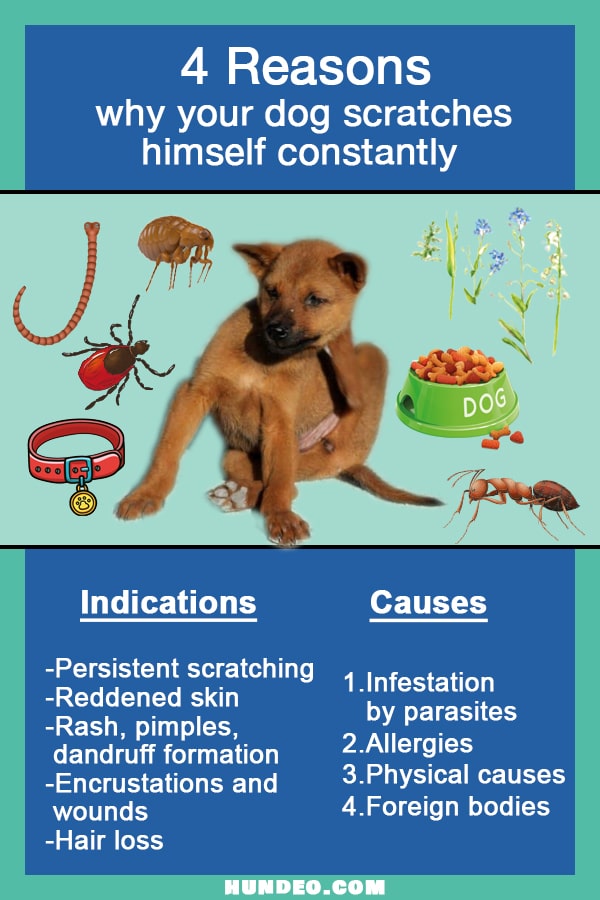Dog is constantly scratching? (4 reasons and what helps against it)
- Veterinarian Mag.med.vet. Emin Jasarevic
- Updated: 2024-02-06
If your dog scratches, nibbles or rubs his fur frequently, he may be suffering from severe itching. Something like this can become a torment and must be treated early. Today I'll explain to you exactly the possible causes of itching and what solutions there are. In addition, for this article we have Advice from veterinarian Mag.med.vet. Emin Jasarevic obtained. Note: This article is written for the german country. So be curious!

Basically, scratching is a completely normal reaction against itching.
Dog itching
Depending on where the stimulus is located, your protégé scratches himself with his claws. He may also nibble with his teeth or rub against a solid object.
Clear signs of itching with a questionable cause are:
- Flapping or twitching movements with the hind legs during petting
- Persistent scratching
- Reddened skin
- Rash, pimples, scaling
- Incrustations and wounds
- Hair loss
The causes of itching

The causes are many and range from parasites, allergies, skin problems, psychological causes to foreign objects and collars.
1. infestation of parasites
Parasites are a major cause of itching in dogs, especially in the warmer months. It is important to recognize signs early and act accordingly.
Fleas
To identify fleas, use a flea comb and look for black crumbs of dirt in the coat, which are flea droppings. A bath with anti-flea shampoo and regular brushing can help with early infestations. It is important to remove all flea eggs and larvae and to thoroughly clean your dog's bedding and accessories.
Mites
Common mites are grass mites, autumn grass mites and burrowing mites. They prefer warm seasons and tender skin areas such as between the toes, ears, legs and on the lower abdomen. If the ears are constantly scratched, ear mange could be present, recognizable by dark dirt in the ears. Special cleaning products can help initially, but if pain or complications are suspected, a vet should be consulted. Red pustules and crusty elbows are further signs of a mite infestation.
Ticks
Ticks lurk on plants and can release pain-relieving secretions into the skin when they bite, causing itching. Quick and proper removal of the tick is essential to avoid skin injuries and the transmission of diseases such as Lyme disease. To do this, use tick tweezers and pull the tick out vertically without leaving the head in the skin. If you are unsure, it is advisable to consult a vet.
2. itching due to allergies
Another big factor for itching is allergies. Unfortunately, they are also steadily increasing in our dogs.
Flea saliva
As a rule, the reaction is triggered by a single flea infestation and occurs predominantly in the groin, loin region and on the tail. If flea saliva gets on the skin, an allergic dog reacts to it with itching.
Affected are mainly animals from the second to sixth year of life.
You can recognize the disease by swelling and crusting of the skin and hair loss. The vet can confirm the allergy by means of a blood test. Treatment involves removing the fleas and soothing the skin.
Food allergy
It occurs in many cases and can afflict dogs of all ages. Chemical additives, flavor enhancers and colorants in the food are responsible. But the most common cause is usually certain protein sources and cereals. An intolerance to lactose can also cause allergies.
- Stomach and intestinal problems
- Bad breath
- Mucus in feces and vomit
- increased hair loss
Environmental allergy
- Dry skin
- excessive dandruff
- Incrustations and wounds
- Redness
- bald spots on the coat
Contact allergy
It occurs when your faithful companion comes into contact with pesticides, fertilizers, chemicals, poisonous plants or metals through the nose or body.
The skin is increasingly affected by synthetic fibers and nickel on the harness. Be careful with collars with metal decorations, they may contain nickel.
The stressed skin develops red pustules and spots. The allergy disappears if the trigger is avoided. A soothing skin cream helps to relieve the itching until the skin has recovered.
3. physical causes
Scratching the buttocks
If your dog rubs its rear end on the floor or licks it conspicuously hard, this may be due to dirt residue or full anal glands.
With very young, older or sick pelt-noses, it can happen that defecation or keeping clean no longer works properly. Sometimes he eats a lot of grass and the stalks don't get all the way out and hang out of the anus. Such residues can be easily removed with a damp cloth.
If the anal glands are clogged, he slides with his butt on the floor. If the glands are clogged, it is best to have them expressed by a veterinarian.
Other causes of an itchy anus are worms. These include tapeworms, roundworms and hookworms.
Dry or flaky skin
This can be caused by diet, too frequent bathing or genetics. If the skin suffers a deficiency or excess of vital nutrients such as zinc, minerals and vitamins, its metabolism becomes imbalanced. The skin dries out, forms scales and itches.
On the packaging of the dog food you can see and check the information of vitamins, minerals and essential fatty acids. If there is a deficiency of vitamins, sometimes a small dose already helps Fish oil, a nutritional supplement or a change of feed.
Body care
Itching on the teats or sebaceous glands
Psychological scratching
4. other causes
Some causes of itching are easily remedied:
Foreign body
Sometimes the ear itches because an ant or bug has got lost in it and is irritating the skin. Your faithful companion tries to get rid of the intruder by scratching, rubbing or shaking. It will hold its head at an angle and make itself known to you by looking, nudging or rubbing. Be careful, as the eardrum could be affected.
If the foreign body is deep-seated and your pet expresses pain, you must be very careful.
Collar, chest harness and muzzle
As a rule, your darling gets used to wearing these things after a while. But at the beginning he often tries to get rid of the load by scratching or shaking.
First you should determine whether the attached part fits properly and whether there is dirt, parasites or stitches underneath. If you take the harness off for a while and the reaction stops, you will be able to tell whether this is the cause of the scratching. After a slow familiarization phase, your pet will accept the harness.
How can I prevent?
Spot-on medication from the vet
To prevent parasites such as fleas and ticks, we recommend using a spot-on product. This is applied directly to the dog's neck where it cannot lick it off.
Grass mite prevention
To minimize grass mite infestations, keep the grass areas around the house short. This reduces the mites' habitat. Shoes to protect the paws can be useful for particularly susceptible dogs.
Worming
Regular worming is important to prevent worm infestation. The vet can recommend the right product depending on your pet's needs.
Feed quality and allergy prevention
A healthy intestinal flora can prevent allergies. Therefore, choose high-quality food without sugar and artificial additives. Barfeeding (organic raw food) can also be beneficial for your dog's health.
Regular personal hygiene
Grooming the ears, teeth, toenails and, if necessary, the rear end helps to prevent itching.
Healing processes and skin care
Itching can be a sign of the healing process and disappears as the skin heals. Frequent stroking promotes the skin's oil production and keeps it supple.
Social needs
As dogs are pack animals, it is important that they are alone as little as possible to avoid stress and the resulting itching.
Skin regeneration and Bach flowers
After overcoming the cause of itching, the skin needs time to regenerate. Bach flowers for animals can play a supporting role in the treatment.
By combining these measures, you can protect your dog's health and reduce the risk of itching.
Frequently Asked Questions
There are very many triggers for itching and scratching in dogs. These can be harmless and pass on their own, or they can be caused by disease, allergies, or parasite infestations. If your dog's scratching becomes noticeable, you should get to the bottom of it.
Basically, scratching is a normal reaction against itching. Clear signs of itching with alarming causes are:
- When stroking simultaneously beating or twitching movements with the hind legs
- Persistent scratching
- Reddened skin
- Rash, pimples, scaling
- Incrustations and wounds
- Hair loss
Mites are small arachnids that are found almost everywhere. There are species that live in the fur of healthy dogs and do not cause any problems. However, there are also those that can cause severe itching and skin diseases.
Heated coconut oil can stop the itching and smother the mites on the skin. Be sure that it is not too hot, but just warm enough to become liquid. Also, tea tree oil and neem oil, as well as salmon oil preparations can help.
It is best to use a tool that serves only this purpose. If done correctly, you should be able to remove the tick along with its head. For detailed instructions, read our article.
Veterinarian’s Recommendation
Itching can have many causes. Some of them are harmless and can be easily fixed by you. Others, however, definitely need the help of a veterinarian. Here is another infographic with the most important points to pin or print.

If you are not sure about the cause and solution of your pet's itching, I recommend you not to waste time. Even if there is no serious disease behind it, itching itself is a nuisance enough. You know it from your own experience.
My article gives you clarification and assistance, but is not a substitute for a veterinarian. The exact search for causes is tedious, but it will be worth it for you and your dog.

I am a veterinarian and writer on animal health topics. Animals are my passion, and it is my personal goal to create medically accurate articles and videos to educate pet owners as much as possible.
Share Now:

